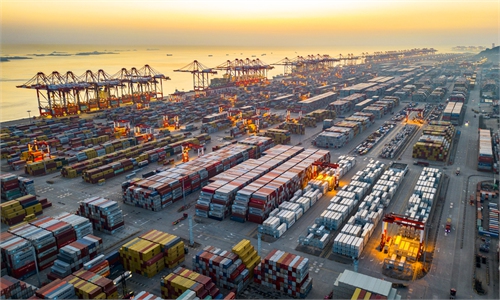March retail sales up 10.6%, strong driver for recovery
Contribution of consumption to 2023 GDP growth to exceed 60%: expert

Customers eat inside a giant concrete pipe built on two layers on top of a barbecue restaurant in Southwest China's Chongqing Municipality on February 7, 2023. Photo: IC
Retail sales, a major driver of economic growth in China, surged 10.6 percent year-on-year in March, beating expectations and hitting a near two-year high. The figure showed the release of huge consumption potential after the optimization of the COVID-19 response and provided strong impetus to the economic recovery in the first quarter.
The better-than-expected first-quarter GDP growth of 4.5 percent indicated that the rebound of the world's second-largest economy is accelerating. The pull of consumption on full-year economic growth will gradually increase, experts and officials said.
The rebound in GDP growth was mainly boosted by much faster growth in the tertiary sector (mainly services), thanks to the end of the epidemic in mid-January, Nomura economists said in a report sent to the Global Times on Tuesday.
In March, retail sales reached 3.79 trillion yuan ($550.7 billion), driving first-quarter consumption up 5.8 percent year-on-year, compared with a 2.7 percent drop in the fourth quarter last year, according to data released by the National Bureau of Statistics (NBS) on Tuesday.
The momentum of the consumption recovery accelerated in March compared with the January-February period, which mirrored a faster-than-expected rebound in personal incomes, led by an uptick in operating incomes, Tian Yun, a veteran economist based in Beijing, told the Global Times on Tuesday.
"Consumption growth rebounded significantly in the first quarter. From the start of this year, with policies aiming to promote consumption rolled out, sales saw a significant recovery, especially in the services," Fu Linghui, spokesperson of the NBS, told a press conference.
In the first quarter, the contribution of consumption to GDP growth reached 66.6 percent, a significant rebound over the whole of last year, becoming the major engine of economic growth, Fu added.
With the impact of the epidemic receding and consumer sentiment improving, contact-related consumption including dining, entertainment and travel grew rapidly, with first-quarter catering revenue up 13.9 percent year-on-year.
"The recovery of the catering industry is an important indicator of the rebound of social activity, and it is a result of the joint efforts of central and local governments to promote consumption," Li Yong, deputy chairman of the Expert Committee of the China Association of International Trade, told the Global Times on Tuesday.
For instance, Zibo, a city in East China's Shandong Province, has gone viral on Chinese social media for its local specialty barbecue. The city has set up special tourist trains and bus routes to attract visitors.
In the first quarter, sales of consumer goods rose 4.9 percent, compared with a 1.7 percent fall in the fourth quarter of 2022.
Retail sales of basic necessities such as food increased by 7.5 percent, while those of discretionary goods like cosmetics rose 5.9 percent.
As the economy stabilized and rebounded and job pressures eased, consumer confidence improved. In the first quarter, the national average propensity to consume reached 62 percent, 0.2 percentage points higher than a year earlier, said Fu.
In the near term, consumption as a driver of GDP growth will remain dominant, Fu said.
The national urban surveyed unemployment rate slid to 5.3 percent in March, which will support personal income growth and spending.
"From a medium- to long-term development perspective, China's per capita GDP has reached $10,000 and is still rising, and the long-term consumption outlook is promising," according to the spokesperson.
Tian predicted that second-quarter retail sales growth could exceed 7 percent on a nominal basis, signaling that the epidemic's impact on consumption will be completely eliminated by that time.
The performance of retail sales in March was just the start of an overall consumption recovery. The contribution of consumption to GDP growth is expected to maintain its current momentum in the second quarter, at around 60 percent, Li said, adding that the coming Golden Week of May Day holidays will inject more impetus into the economy.
"It is expected that the contribution of household consumption to GDP growth this year will exceed 60 percent," according to Tian.
Ding Shuang, Chief Economist of Greater China and North Asia at Standard Chartered Bank, told the Global Times on Tuesday that consumption will rebound and become the main driver of GDP growth this year. It's likely that consumption can contribute 4.0-4.5 percentage points to the country's economic growth.
"In the near future, we will ramp up efforts to increase personal incomes, effectively combine the expansion of consumption and supply-side structural reform, and continuously release consumption potential, in a bid to promote economic development and improve people's well-being," Fu noted.

